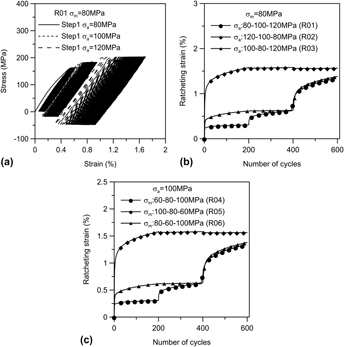Article contents
Ratcheting behavior of ZEK100 magnesium alloy with various loading conditions and different immersing time
Published online by Cambridge University Press: 17 April 2017
Abstract

It is desirable to evaluate the ratcheting behavior of biomedical magnesium under cyclic loading with and without precorrosion, due to the promising future in biomedical implant field. This study focuses on the investigation of the uniaxial ratcheting strain evolutions of ZEK100 magnesium alloy sheet under various loading conditions and different corrosion time. To illustrate the ratcheting response in detail, the effects of several factors on the ratcheting strain evolution were discussed, including mean stress, stress amplitude, specimen orientations, loading history, and precorroded duration. A series of asymmetrical multistep stress-controlled ratcheting tests were conducted. The mean stress, stress amplitude, and precorrosion duration have significant influence on the ratcheting response of material. ZEK100 magnesium alloy is sensitive to loading history. ZEK100 magnesium alloy exhibits anisotropic behavior, and it is found that the final ratcheting strain of transverse direction (TD) specimens is always larger than that of rolling direction (RD) specimens. The corrosion behavior of ZEK100 magnesium alloy in phosphate buffered solution (PBS) simulated physiological environment was also studied. The corrosion process is characterized by pitting corrosion, and the corrosion rate of material stabilizes at about 2.4 g/(m2 d) after an exponentially decrease at initial stage.
Keywords
- Type
- Articles
- Information
- Copyright
- Copyright © Materials Research Society 2017
Footnotes
Contributing Editor: Michele Manuel
References
REFERENCES
- 12
- Cited by





